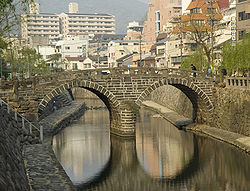Megane Bridge: Difference between revisions
m General fixes, removed erroneous space |
mNo edit summary |
||
| Line 5: | Line 5: | ||
{{maplink|frame=yes|frame-width=250|zoom=17|type=line}} |
{{maplink|frame=yes|frame-width=250|zoom=17|type=line}} |
||
{{Nihongo|'''Meganebashi'''|眼鏡橋}} or '''Spectacles Bridge''', over the [[:ja:中島川|Nakashima River (中島川)]] was built in [[Nagasaki]] in 1634<ref>{{Structurae | id = 20010554 | title = Megane Bridge | accessdate = 2009-12-07}}</ref> by the [[Chinese people|Chinese]] monk Mokusunyoujo who was in the second generation of Chinese monks living at [[Kōfuku-ji (Nagasaki)|Kofukuji]] Temple. It is said to be the oldest stone [[arch bridge]] in [[Japan]] along with Edo's [[Nihonbashi]] bridge and Iwakuni's [[Kintai Bridge|Kintaikyou bridge]]<ref>{{cite web|url=http://travel.at-nagasaki.jp/en/what-to-see/26/|title=Megane-Bashi (Spectacles Bridge)|first=Nagasaki Tourism Homepage Administration|last=Committee|website=Welcome! VISIT Nagasaki}}</ref> and has been designated as an [[Important Cultural Properties of Japan|Important Cultural Property]]. Megane Bridge is also part of the first group of bridges built over Nakashima river. Megane Bridge is made of stone and is a double arch bridge. It received the nickname "Spectacles Bridge" because its two arches and their reflection in the water create the image of a pair of spectacles. Vehicles are prohibited from crossing the bridge and is strictly prohibited to pedestrians only. |
{{Nihongo|'''Meganebashi'''|眼鏡橋}} or '''Spectacles Bridge''', over the [[:ja:中島川|Nakashima River (中島川)]] was built in [[Nagasaki]] in 1634<ref>{{Structurae | id = 20010554 | title = Megane Bridge | accessdate = 2009-12-07}}</ref> by the [[Chinese people|Chinese]] monk Mokusunyoujo who was in the second generation of Chinese monks living at [[Kōfuku-ji (Nagasaki)|Kofukuji]] Temple. It is said to be the oldest stone [[arch bridge]] in [[Japan]] along with Edo's [[Nihonbashi]] bridge and Iwakuni's [[Kintai Bridge|Kintaikyou bridge]]<ref>{{cite web|url=http://travel.at-nagasaki.jp/en/what-to-see/26/|title=Megane-Bashi (Spectacles Bridge)|first=Nagasaki Tourism Homepage Administration|last=Committee|website=Welcome! VISIT Nagasaki}}</ref> and has been designated as an [[Important Cultural Properties of Japan|Important Cultural Property]]. Megane Bridge is also part of the first group of bridges built over Nakashima river. Megane Bridge is made of stone and is a double arch bridge. It received the nickname "Spectacles Bridge" because its two arches and their reflection in the water create the image of a pair of spectacles. Vehicles are prohibited from crossing the bridge and is strictly prohibited to pedestrians only. |
||
On July 23, 1982, a disastrous deluge washed away six of the ten stone bridges over the Nakashima River. Meganebashi was badly damaged but almost all the original stones were retrieved and the bridge was restored to its original appearance. As well as being damaged in a flood in 1982 another flood in 1647 destroyed Megane Bridge but was rebuilt the following year in 1648 by Koumu Hirado.<ref>{{cite web|url=https://planetyze.com/en/japan/nagasaki/meganebashi-spectacles-bridge/information|title=About Meganebashi (Spectacles) Bridge - Nagasaki Things To Do & Itineraries|website=Planetyze}}</ref> |
On July 23, 1982, a [[1982 Nagasaki flood|disastrous deluge]] washed away six of the ten stone bridges over the Nakashima River. Meganebashi was badly damaged but almost all the original stones were retrieved and the bridge was restored to its original appearance. As well as being damaged in a flood in 1982 another flood in 1647 destroyed Megane Bridge but was rebuilt the following year in 1648 by Koumu Hirado.<ref>{{cite web|url=https://planetyze.com/en/japan/nagasaki/meganebashi-spectacles-bridge/information|title=About Meganebashi (Spectacles) Bridge - Nagasaki Things To Do & Itineraries|website=Planetyze}}</ref> |
||
There is a similar but larger "[[Isahaya Park#Meganebashi|Spectacles Bridge]]" in [[Isahaya Park]]. |
There is a similar but larger "[[Isahaya Park#Meganebashi|Spectacles Bridge]]" in [[Isahaya Park]]. |
||
Revision as of 01:28, 22 January 2023
This article needs additional citations for verification. (December 2009) |

Meganebashi (眼鏡橋) or Spectacles Bridge, over the Nakashima River (中島川) was built in Nagasaki in 1634[1] by the Chinese monk Mokusunyoujo who was in the second generation of Chinese monks living at Kofukuji Temple. It is said to be the oldest stone arch bridge in Japan along with Edo's Nihonbashi bridge and Iwakuni's Kintaikyou bridge[2] and has been designated as an Important Cultural Property. Megane Bridge is also part of the first group of bridges built over Nakashima river. Megane Bridge is made of stone and is a double arch bridge. It received the nickname "Spectacles Bridge" because its two arches and their reflection in the water create the image of a pair of spectacles. Vehicles are prohibited from crossing the bridge and is strictly prohibited to pedestrians only. On July 23, 1982, a disastrous deluge washed away six of the ten stone bridges over the Nakashima River. Meganebashi was badly damaged but almost all the original stones were retrieved and the bridge was restored to its original appearance. As well as being damaged in a flood in 1982 another flood in 1647 destroyed Megane Bridge but was rebuilt the following year in 1648 by Koumu Hirado.[3]
There is a similar but larger "Spectacles Bridge" in Isahaya Park.
Near Megane Bridge are 20 heart shaped stone within the bridge's embankment from which you can make a wish for eternal love. It is also said that the more heart shaped stones you find the more lucky you will be.
Notes
- ^ Megane Bridge at Structurae. Retrieved 2009-12-07.
- ^ Committee, Nagasaki Tourism Homepage Administration. "Megane-Bashi (Spectacles Bridge)". Welcome! VISIT Nagasaki.
- ^ "About Meganebashi (Spectacles) Bridge - Nagasaki Things To Do & Itineraries". Planetyze.
32°44′50″N 129°52′48″E / 32.747207°N 129.880087°E

